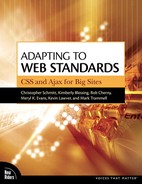0%
20Chapters
0-1Hours read
0kTotal Words
Book Description
After learning the language of design, how does one effectively use standards-based technologies to create visually strong Web sites? The full-color Adapting to Web Standards: CSS and Ajax for Big Sites gives developers a peek into the process of the best designers in the world through the work of high profile, real-world Web sites that made them famous. The book focuses on deconstructing these top-tier large-scale sites with particular attention given to deconstructing CSS.
Table of Contents
- Copyright
- Acknowledgements
- About the Authors
- 1. Constructing Standards-Based Web Sites
- Introduction
- 1. Coding the Front End
- 2. Presenting Cascading Style Sheets
- 3. Integrating the Behavior Layer
- 4. Developing Web Software Applications
- 5. The Circle of Standards
- 2. Case Studies
- Afterword
- A. Targeting Web Browsers
- B. Accessibility
- C. Web Site Performance Tips
- D. CSS Selectors Reference
- Reinventing Yahoo!
